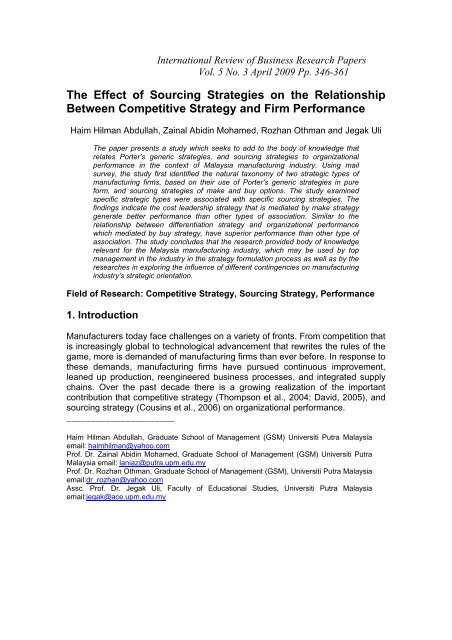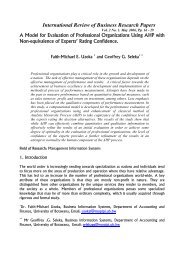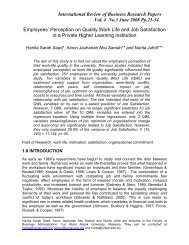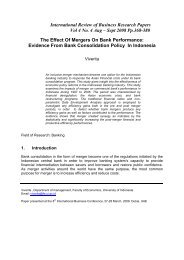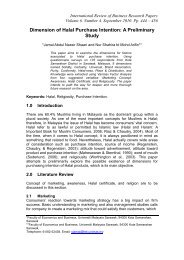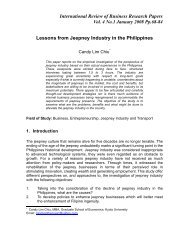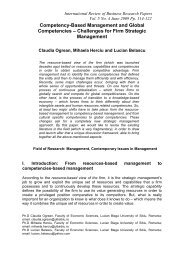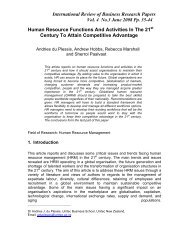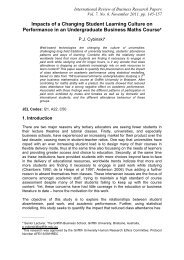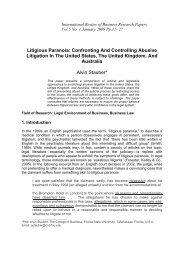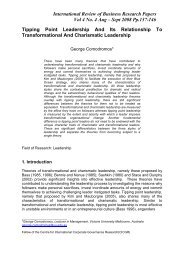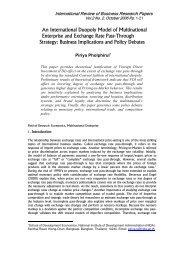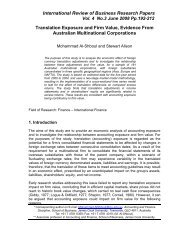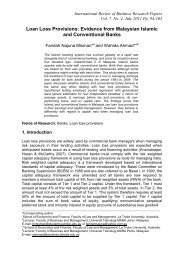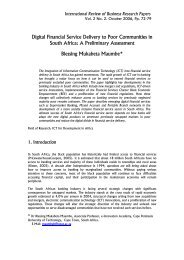The Effect of Sourcing Strategies on the Relationship Between ...
The Effect of Sourcing Strategies on the Relationship Between ...
The Effect of Sourcing Strategies on the Relationship Between ...
Create successful ePaper yourself
Turn your PDF publications into a flip-book with our unique Google optimized e-Paper software.
Internati<strong>on</strong>al Review <str<strong>on</strong>g>of</str<strong>on</strong>g> Business Research PapersVol. 5 No. 3 April 2009 Pp. 346-361<str<strong>on</strong>g>The</str<strong>on</strong>g> <str<strong>on</strong>g>Effect</str<strong>on</strong>g> <str<strong>on</strong>g>of</str<strong>on</strong>g> <str<strong>on</strong>g>Sourcing</str<strong>on</strong>g> <str<strong>on</strong>g>Strategies</str<strong>on</strong>g> <strong>on</strong> <strong>the</strong> Relati<strong>on</strong>ship<strong>Between</strong> Competitive Strategy and Firm PerformanceHaim Hilman Abdullah, Zainal Abidin Mohamed, Rozhan Othman and Jegak Uli<str<strong>on</strong>g>The</str<strong>on</strong>g> paper presents a study which seeks to add to <strong>the</strong> body <str<strong>on</strong>g>of</str<strong>on</strong>g> knowledge thatrelates Porter’s generic strategies, and sourcing strategies to organizati<strong>on</strong>alperformance in <strong>the</strong> c<strong>on</strong>text <str<strong>on</strong>g>of</str<strong>on</strong>g> Malaysia manufacturing industry. Using mailsurvey, <strong>the</strong> study first identified <strong>the</strong> natural tax<strong>on</strong>omy <str<strong>on</strong>g>of</str<strong>on</strong>g> two strategic types <str<strong>on</strong>g>of</str<strong>on</strong>g>manufacturing firms, based <strong>on</strong> <strong>the</strong>ir use <str<strong>on</strong>g>of</str<strong>on</strong>g> Porter’s generic strategies in pureform, and sourcing strategies <str<strong>on</strong>g>of</str<strong>on</strong>g> make and buy opti<strong>on</strong>s. <str<strong>on</strong>g>The</str<strong>on</strong>g> study examinedspecific strategic types were associated with specific sourcing strategies. <str<strong>on</strong>g>The</str<strong>on</strong>g>findings indicate <strong>the</strong> cost leadership strategy that is mediated by make strategygenerate better performance than o<strong>the</strong>r types <str<strong>on</strong>g>of</str<strong>on</strong>g> associati<strong>on</strong>. Similar to <strong>the</strong>relati<strong>on</strong>ship between differentiati<strong>on</strong> strategy and organizati<strong>on</strong>al performancewhich mediated by buy strategy, have superior performance than o<strong>the</strong>r type <str<strong>on</strong>g>of</str<strong>on</strong>g>associati<strong>on</strong>. <str<strong>on</strong>g>The</str<strong>on</strong>g> study c<strong>on</strong>cludes that <strong>the</strong> research provided body <str<strong>on</strong>g>of</str<strong>on</strong>g> knowledgerelevant for <strong>the</strong> Malaysia manufacturing industry, which may be used by topmanagement in <strong>the</strong> industry in <strong>the</strong> strategy formulati<strong>on</strong> process as well as by <strong>the</strong>researches in exploring <strong>the</strong> influence <str<strong>on</strong>g>of</str<strong>on</strong>g> different c<strong>on</strong>tingencies <strong>on</strong> manufacturingindustry’s strategic orientati<strong>on</strong>.Field <str<strong>on</strong>g>of</str<strong>on</strong>g> Research: Competitive Strategy, <str<strong>on</strong>g>Sourcing</str<strong>on</strong>g> Strategy, Performance1. Introducti<strong>on</strong>Manufacturers today face challenges <strong>on</strong> a variety <str<strong>on</strong>g>of</str<strong>on</strong>g> fr<strong>on</strong>ts. From competiti<strong>on</strong> thatis increasingly global to technological advancement that rewrites <strong>the</strong> rules <str<strong>on</strong>g>of</str<strong>on</strong>g> <strong>the</strong>game, more is demanded <str<strong>on</strong>g>of</str<strong>on</strong>g> manufacturing firms than ever before. In resp<strong>on</strong>se to<strong>the</strong>se demands, manufacturing firms have pursued c<strong>on</strong>tinuous improvement,leaned up producti<strong>on</strong>, reengineered business processes, and integrated supplychains. Over <strong>the</strong> past decade <strong>the</strong>re is a growing realizati<strong>on</strong> <str<strong>on</strong>g>of</str<strong>on</strong>g> <strong>the</strong> importantc<strong>on</strong>tributi<strong>on</strong> that competitive strategy (Thomps<strong>on</strong> et al., 2004; David, 2005), andsourcing strategy (Cousins et al., 2006) <strong>on</strong> organizati<strong>on</strong>al performance.______________________Haim Hilman Abdullah, Graduate School <str<strong>on</strong>g>of</str<strong>on</strong>g> Management (GSM) Universiti Putra Malaysiaemail: haimhilman@yahoo.comPr<str<strong>on</strong>g>of</str<strong>on</strong>g>. Dr. Zainal Abidin Mohamed, Graduate School <str<strong>on</strong>g>of</str<strong>on</strong>g> Management (GSM) Universiti PutraMalaysia email: laniaz@putra.upm.edu.myPr<str<strong>on</strong>g>of</str<strong>on</strong>g>. Dr. Rozhan Othman, Graduate School <str<strong>on</strong>g>of</str<strong>on</strong>g> Management (GSM), Universiti Putra Malaysiaemail:dr_rozhan@yahoo.comAssc. Pr<str<strong>on</strong>g>of</str<strong>on</strong>g>. Dr. Jegak Uli, Faculty <str<strong>on</strong>g>of</str<strong>on</strong>g> Educati<strong>on</strong>al Studies, Universiti Putra Malaysiaemail:jegak@ace.upm.edu.my
Abdullah, Mohamed, Othman & Uli<str<strong>on</strong>g>The</str<strong>on</strong>g> overall objective <str<strong>on</strong>g>of</str<strong>on</strong>g> <strong>the</strong> study was to examine <strong>the</strong> use <str<strong>on</strong>g>of</str<strong>on</strong>g> Porter’s genericstrategies, sourcing strategies, and <strong>the</strong>ir effect <strong>on</strong> organizati<strong>on</strong>al performance in<strong>the</strong> c<strong>on</strong>text <str<strong>on</strong>g>of</str<strong>on</strong>g> Malaysia manufacturing industry. <str<strong>on</strong>g>The</str<strong>on</strong>g> study first identifies <strong>the</strong>natural tax<strong>on</strong>omy <str<strong>on</strong>g>of</str<strong>on</strong>g> strategic types firms, based <strong>on</strong> <strong>the</strong>ir use <str<strong>on</strong>g>of</str<strong>on</strong>g> genericstrategies in pure form. Next it examines whe<strong>the</strong>r specific strategic types wereassociated with specific sourcing strategies and organizati<strong>on</strong>al performance.Fur<strong>the</strong>r <strong>the</strong> study discusses <strong>the</strong> findings and hypo<strong>the</strong>sizes about <strong>the</strong>ir possibleexplanati<strong>on</strong>s. Finally, c<strong>on</strong>clusi<strong>on</strong>s are drawn and <strong>the</strong>ir implicati<strong>on</strong>s for managersare discussed.2. Literature Review2.1 Competitive StrategyPorter’s (1985) define strategy as positi<strong>on</strong>ing a business to maximize <strong>the</strong> value <str<strong>on</strong>g>of</str<strong>on</strong>g><strong>the</strong> capabilities that distinguish it from its competitors. According to Porter,distinctive value can be achieved by pursuing <strong>the</strong> following generic strategies:cost leadership, differentiati<strong>on</strong> and focus. He maintained that his strategies weremutually exclusive or at least n<strong>on</strong>-complementary and referred to firms thatattempt to pursue more than <strong>on</strong>e generic strategy as “stuck in <strong>the</strong> middle”.Despite <strong>the</strong> differences all strategy frameworks have <strong>on</strong>e thing in comm<strong>on</strong> whichis that <strong>the</strong>y all aim at maximizing <strong>the</strong> performance <str<strong>on</strong>g>of</str<strong>on</strong>g> an organizati<strong>on</strong> improvingits competitiveness in relati<strong>on</strong> to its competitors in <strong>the</strong> same competitiveenvir<strong>on</strong>ment (Feurer & Chaharbaghi, 1997). Porter drew up<strong>on</strong> <strong>the</strong> frameworks <str<strong>on</strong>g>of</str<strong>on</strong>g>industrial ec<strong>on</strong>omics which is embedded to industrial ec<strong>on</strong>omics <strong>the</strong>ory (IO<str<strong>on</strong>g>The</str<strong>on</strong>g>ory), which is better explained through <strong>the</strong> following simple paradigm(Shortell & Kalunzy, 1994):Market Structure Firm C<strong>on</strong>duct PerformanceBy introducing <strong>the</strong> c<strong>on</strong>cept <str<strong>on</strong>g>of</str<strong>on</strong>g> industrial analysis Porter (1985) fur<strong>the</strong>r providedinsight into structures within different competitive envir<strong>on</strong>ments. This c<strong>on</strong>ceptassumes five competitive forces illustrated in Figure 1.1.347
Abdullah, Mohamed, Othman & UliFigure 1.1: Porter’s Five ForcesPotential development<str<strong>on</strong>g>of</str<strong>on</strong>g> substitute productsBargaining power Rivalry am<strong>on</strong>g Bargaining power<str<strong>on</strong>g>of</str<strong>on</strong>g> suppliers competing firms <str<strong>on</strong>g>of</str<strong>on</strong>g> c<strong>on</strong>sumerPotential entry<str<strong>on</strong>g>of</str<strong>on</strong>g> new competitorsOrganizati<strong>on</strong>s must c<strong>on</strong>stantly adapt to fast changing circumstances and, hence,move towards dynamic strategy development (Feurer & Chaharbaghi, 1997).Those frameworks and c<strong>on</strong>cepts have provided a better understanding <str<strong>on</strong>g>of</str<strong>on</strong>g>strategy. It was <strong>the</strong>refore felt that <strong>the</strong> framework <str<strong>on</strong>g>of</str<strong>on</strong>g> Porter’s generic strategiescould still employed in Malaysia manufacturing industry for generatingknowledge, which may be used in <strong>the</strong> formulati<strong>on</strong> and implementati<strong>on</strong> <str<strong>on</strong>g>of</str<strong>on</strong>g>strategies.2.1.1 Porter’s generic strategies<str<strong>on</strong>g>The</str<strong>on</strong>g> strategic typology developed by Porter (1980) emphasizes two types <str<strong>on</strong>g>of</str<strong>on</strong>g>competitive advantage: cost leadership and differentiati<strong>on</strong>. Both <str<strong>on</strong>g>of</str<strong>on</strong>g> <strong>the</strong>mrepresent what Porter calls “generic strategies”. A third generic strategy is asubset <str<strong>on</strong>g>of</str<strong>on</strong>g> <strong>the</strong> o<strong>the</strong>r two. This strategy is focus. Porter’s generic strategies implydifferent organizati<strong>on</strong>al arrangements, c<strong>on</strong>trol procedures, and incentivesystems.2.1.1.1 Cost leadershipA primary reas<strong>on</strong> for pursuing forward, backward, and horiz<strong>on</strong>tal integrati<strong>on</strong>strategies to gain cost leadership benefits. Am<strong>on</strong>g cost elements to c<strong>on</strong>sider arefacilities, operati<strong>on</strong>s, overheads, cost saving from experience, and beingrelatively frugal in such areas as R&D, service, sales force, training anddevelopment and advertising (Porter, 1980; Hlavacka et al., 2001). Striving to be<strong>the</strong> low-cost producer in an industry can be especially effective when <strong>the</strong> marketis composed <str<strong>on</strong>g>of</str<strong>on</strong>g> many price-sensitive buyers, when <strong>the</strong>re are few ways to achieveproduct differentiati<strong>on</strong>, when buyers do not care much about differences frombrand to brand, or when <strong>the</strong>re are a large number <str<strong>on</strong>g>of</str<strong>on</strong>g> buyers with significant348
Abdullah, Mohamed, Othman & Ulibargaining power (Porter, 1980; Malburg, 2000; Venu, 2001; Davids<strong>on</strong>, 2001;Allen et al., 2006).. <str<strong>on</strong>g>The</str<strong>on</strong>g> basic idea is to underprice competitors and <strong>the</strong>reby gainmarket share and sales, driving some competitors out <str<strong>on</strong>g>of</str<strong>on</strong>g> <strong>the</strong> market entirely(Porter, 1980).2.1.1.2 Differentiati<strong>on</strong>Firms that adopt a differentiati<strong>on</strong> strategy seek to establish fundamentaldifferences in a variety <str<strong>on</strong>g>of</str<strong>on</strong>g> dimensi<strong>on</strong>s so that buyers perceive a marked c<strong>on</strong>trastbetween <strong>the</strong> products <str<strong>on</strong>g>of</str<strong>on</strong>g> <strong>on</strong>e firm and its rivals. A firm focuses <strong>on</strong> providing aunique product or service (Porter, 1980; Cross, 1999; Hyatt, 2001; Bauer &Colgan, 2001; Hlavacka et al., 2001). Successful differentiati<strong>on</strong> can mean greaterproduct flexibility, greater compatibility, and more features (Porter, 1980;Davids<strong>on</strong>, 2001; McCracken, 2002; Allen et al., 2006). Differentiati<strong>on</strong> yields highmargins with which to deal with supplier power and clearly mitigates buyer powersince buyers lack comparable alternatives and are <strong>the</strong>reby allows a firm tocharge a higher price for its products (Porter, 1980; Venu, 2001; Hlavacka et al.,2001).2.1.2 <str<strong>on</strong>g>Sourcing</str<strong>on</strong>g> strategiesCapr<strong>on</strong> and Mitchell (2004) define make as when a firm recombine its existingresources or developing new resources <strong>on</strong> its own; and buy as when a firm tradeits activities that held in a strategic capability which stems from external sources.<str<strong>on</strong>g>The</str<strong>on</strong>g> sourcing decisi<strong>on</strong> can <str<strong>on</strong>g>of</str<strong>on</strong>g>ten be a major determinant <str<strong>on</strong>g>of</str<strong>on</strong>g> pr<str<strong>on</strong>g>of</str<strong>on</strong>g>itability, making asignificant c<strong>on</strong>tributi<strong>on</strong> to <strong>the</strong> financial health <str<strong>on</strong>g>of</str<strong>on</strong>g> <strong>the</strong> firm (Yo<strong>on</strong> & Naadimuthu,1994; McIvor et al., 1997). <str<strong>on</strong>g>The</str<strong>on</strong>g> sourcing strategy espoused by a firm may focus<strong>on</strong> cost leadership, differentiati<strong>on</strong>, or o<strong>the</strong>r intents which form <strong>the</strong> basis <str<strong>on</strong>g>of</str<strong>on</strong>g> <strong>the</strong>competitive edge (Porter, 1980). One <str<strong>on</strong>g>of</str<strong>on</strong>g> <strong>the</strong> distinguishing attributes <str<strong>on</strong>g>of</str<strong>on</strong>g> effectivesourcing strategy is that, it plays an integrative role in <strong>the</strong> firm’s strategic planningprocess (Reck & L<strong>on</strong>g, 1988, Ammer, 1989; Carr et al., 2000; Carr & Pears<strong>on</strong>,2002); and <strong>the</strong> key to succeed in achieving such integrati<strong>on</strong> lies in <strong>the</strong> skills andcapabilities <str<strong>on</strong>g>of</str<strong>on</strong>g> <strong>the</strong> people who work in <strong>the</strong> purchasing functi<strong>on</strong> (Reck & L<strong>on</strong>g,1988; Carr & Pears<strong>on</strong>, 2002).2.1.2.1 Make StrategyFirms may opt for make strategy when targeted capabilities do not exist outside<strong>the</strong> firm or even if <strong>the</strong>y do exist, <strong>the</strong>y cannot be traded through markets or acrossfirms (Capr<strong>on</strong> & Mitchell, 2004), or when suppliers do not want to trade uniqueand valuable resources (Dierickx & Cool, 1989). To remain competitive, firmsneed to develop <strong>the</strong> ability to recombine its internal capabilities into newc<strong>on</strong>figurati<strong>on</strong>s <str<strong>on</strong>g>of</str<strong>on</strong>g> capabilities (Henders<strong>on</strong> & Clark, 1990; Galunic & Rodan, 1998).349
Abdullah, Mohamed, Othman & UliC<strong>on</strong>sistent with knowledge-based <strong>the</strong>orists and instituti<strong>on</strong>al <strong>the</strong>orists, <strong>the</strong>targeted and existing capabilities <str<strong>on</strong>g>of</str<strong>on</strong>g> make strategy targeted capabilities arenarrow (Capr<strong>on</strong> & Mitchell, 2004), which means it is suitable for <strong>the</strong> development<str<strong>on</strong>g>of</str<strong>on</strong>g> capabilities that do not depart significantly from <strong>the</strong> firm’s routines and socialvalues. However, owing to rapid changes in <strong>the</strong> market, this strategy makes firmsless flexible (Hayes & Abernathy, 1980). Due to <strong>the</strong> gap in <strong>the</strong> literature withregards to <strong>the</strong> relati<strong>on</strong>ship between cost leadership strategy and make strategy,<strong>the</strong>se attributes indirectly indicates <strong>the</strong> nature <str<strong>on</strong>g>of</str<strong>on</strong>g> <strong>the</strong> make strategy is c<strong>on</strong>sistentwith <strong>the</strong> cost leadership strategy <str<strong>on</strong>g>of</str<strong>on</strong>g> <strong>the</strong> Porter’s generic strategies which highlyassociated with internal development, low cost, learning curve benefits, andec<strong>on</strong>omies <str<strong>on</strong>g>of</str<strong>on</strong>g> scale (Porter, 1980; Malburg, 2000; Venu, 2001; Davids<strong>on</strong>, 2001;Allen et al., 2006).2.1.2.2 Buy StrategyBuy strategy or outsourcing can be defined as an act <str<strong>on</strong>g>of</str<strong>on</strong>g> moving some <str<strong>on</strong>g>of</str<strong>on</strong>g> a firm’sinternal activities and decisi<strong>on</strong> resp<strong>on</strong>sibilities to outside providers (Lankford &Parsa, 1999; Chase et al., 2004). Firms nowadays tend to c<strong>on</strong>tract out moremanufacturing and service activities than <strong>the</strong>y did a decade ago (Fuller, 2002).This trend has been driven by changes in <strong>the</strong> business envir<strong>on</strong>ment and <strong>the</strong>pursuit <str<strong>on</strong>g>of</str<strong>on</strong>g> lean operati<strong>on</strong>s (Hui & Tsang, 2004). Through <strong>the</strong> buy strategy, firmscould secure advantages such as ec<strong>on</strong>omies <str<strong>on</strong>g>of</str<strong>on</strong>g> scale (mass producti<strong>on</strong>) andscope (specializati<strong>on</strong>), cost reducti<strong>on</strong>, quality, service and delivery improvement,organizati<strong>on</strong>al focus, greater product flexibility, and better chances to exploitchange facilitati<strong>on</strong> provided by external suppliers (McIvor et al., 1997; Fan, 2000;Zeng, 2000; Kakabadse & Kakabadse, 2000; Jennings, 2002; Hui & Tsang,2004; Gilbert et al., 2006).<str<strong>on</strong>g>The</str<strong>on</strong>g> literature clearly indicates <strong>the</strong> characteristics <str<strong>on</strong>g>of</str<strong>on</strong>g> buy strategy anddifferentiati<strong>on</strong> strategy but very little empirical evidence relating to <strong>the</strong> associati<strong>on</strong>between <strong>the</strong>se two variables. However, <strong>the</strong>ir respective characteristics are verymuch similar as <strong>the</strong> differentiati<strong>on</strong> strategy favors unique product (Porter, 1980;Cross, 1999; Hyatt, 2001; Bauer & Colgan, 2001; Hlavacka et al., 2001), greaterproduct flexibility, greater compatibility, and more features (Porter, 1980;Davids<strong>on</strong>, 2001; McCracken, 2002; Allen et al., 2006). Fur<strong>the</strong>rmore bothstrategies yield high margins through <strong>the</strong> mitigati<strong>on</strong> <str<strong>on</strong>g>of</str<strong>on</strong>g> buyer power since buyerslack comparable alternatives and <strong>the</strong>reby allow firms to charge a higher price forits products (Porter, 1980; Venu, 2001; Hlavacka et al., 2001).350
Abdullah, Mohamed, Othman & Uli2.1.3 Porter’s Types, <str<strong>on</strong>g>Sourcing</str<strong>on</strong>g> <str<strong>on</strong>g>Strategies</str<strong>on</strong>g> and Organizati<strong>on</strong>alPerformancePorter (1980) emphasized that generic strategies represent different alternativesto a firm seeking to establish a competitive advantage. Firms that are “stuck in<strong>the</strong> middle” compete at a disadvantage because <strong>the</strong> cost leaders anddifferentiators are all able to c<strong>on</strong>centrate <strong>the</strong>ir capabilities more effectively andsecure better performance (Porter, 1980; Fuerer & Chaharbaghi, 1997; Cross,1999; Hlavacka et al., 2001).<str<strong>on</strong>g>Sourcing</str<strong>on</strong>g> decisi<strong>on</strong> can <str<strong>on</strong>g>of</str<strong>on</strong>g>ten be a major determinant <str<strong>on</strong>g>of</str<strong>on</strong>g> pr<str<strong>on</strong>g>of</str<strong>on</strong>g>itability, making asignificant c<strong>on</strong>tributi<strong>on</strong> to <strong>the</strong> financial health <str<strong>on</strong>g>of</str<strong>on</strong>g> <strong>the</strong> firm (Yo<strong>on</strong> & Naadimuthu,1994; McIvor et al., 1997). One <str<strong>on</strong>g>of</str<strong>on</strong>g> <strong>the</strong> distinguishing attributes <str<strong>on</strong>g>of</str<strong>on</strong>g> effectivesourcing strategy is that, it plays an integrative role in <strong>the</strong> firm’s strategic planningprocess (Reck & L<strong>on</strong>g, 1988, Ammer, 1989; Carr et al., 2000; Carr & Pears<strong>on</strong>,2002).This study drew up<strong>on</strong> <strong>the</strong> framework <str<strong>on</strong>g>of</str<strong>on</strong>g> business level strategy (Porter’s genericstrategies – competitive strategy), functi<strong>on</strong>al level strategy (sourcing strategies),and organizati<strong>on</strong>al performance. <str<strong>on</strong>g>The</str<strong>on</strong>g> framework is best illustrated through <strong>the</strong>following simple paradigm.Competitive Strategy <str<strong>on</strong>g>Sourcing</str<strong>on</strong>g> Strategy Organizati<strong>on</strong>al Performance(Porter’s generic Strategy) (Make or Buy)<str<strong>on</strong>g>The</str<strong>on</strong>g> logic here is that <strong>the</strong> combined effects <str<strong>on</strong>g>of</str<strong>on</strong>g> competitive strategy (independentvariable) and sourcing strategy (mediator variable) influence organizati<strong>on</strong>alperformance (dependent variable).2.1.4 Hypo<strong>the</strong>ses<str<strong>on</strong>g>The</str<strong>on</strong>g> primary research questi<strong>on</strong> for this study is to determine <strong>the</strong> extent to whichspecific sourcing strategy mediate <strong>the</strong> specific competitive strategy in itsrelati<strong>on</strong>ship with organizati<strong>on</strong>al performance. Given <strong>the</strong> gap in <strong>the</strong> literature <strong>on</strong>this perspective, this study intended to addresses <strong>the</strong> proposed hypo<strong>the</strong>ses asfollow:H1: Firms pursuing cost leadership strategy that is mediated by make strategyproduce better organizati<strong>on</strong>al performance than o<strong>the</strong>r type <str<strong>on</strong>g>of</str<strong>on</strong>g> associati<strong>on</strong>.H2: Firms pursuing differentiati<strong>on</strong> strategy that is mediated by buy strategyproduce better organizati<strong>on</strong>al performance than o<strong>the</strong>r type <str<strong>on</strong>g>of</str<strong>on</strong>g> associati<strong>on</strong>.351
Abdullah, Mohamed, Othman & Uli3. Methodology and Research Design<str<strong>on</strong>g>The</str<strong>on</strong>g> data for this study have been collected between May 2008 and July 2008.<str<strong>on</strong>g>The</str<strong>on</strong>g> sample for this study was chosen from <strong>the</strong> Federati<strong>on</strong> <str<strong>on</strong>g>of</str<strong>on</strong>g> MalaysianManufacturers (FMM) 2007 directory. This study aimed to investigate <strong>the</strong>influence <str<strong>on</strong>g>of</str<strong>on</strong>g> sourcing strategy as a mediator variable in <strong>the</strong> relati<strong>on</strong>ship betweencompetitive strategy and organizati<strong>on</strong>al performance.An instrument <str<strong>on</strong>g>of</str<strong>on</strong>g> measure <strong>the</strong> generic strategies were required. This studyadapted an instrument developed and tested by Roth and Morris<strong>on</strong> (1990) whichbased <strong>on</strong> Porter (1980, 1985). Seventeen questi<strong>on</strong>s regarding various strategicpractices were used to operati<strong>on</strong>alized Porter’s generic strategies. For sourcingstrategies, this study used Kotabe and Omura (1989) developed and testedinstrument. Twelve questi<strong>on</strong>s which regards to various sourcing practices wereused to operati<strong>on</strong>alized <strong>the</strong> sourcing strategies. For <strong>the</strong> organizati<strong>on</strong>alperformance, this study combined instrument <str<strong>on</strong>g>of</str<strong>on</strong>g> measure developed and testedby Venkatraman and Ramanujam, (1986); Dess and Robins<strong>on</strong>, (1994); Lee andMiller, (1996); and Kaplan and Nort<strong>on</strong> (1996). Seven questi<strong>on</strong>s regardingfinancial and n<strong>on</strong> financial measures were used to operati<strong>on</strong>alized organizati<strong>on</strong>alperformance.3.1 <str<strong>on</strong>g>The</str<strong>on</strong>g> SampleTo reach a broad range <str<strong>on</strong>g>of</str<strong>on</strong>g> organizati<strong>on</strong>s and ensure a high resp<strong>on</strong>se rate <strong>the</strong>survey was administered to c<strong>on</strong>venience samples <str<strong>on</strong>g>of</str<strong>on</strong>g> Federati<strong>on</strong> <str<strong>on</strong>g>of</str<strong>on</strong>g> MalaysianManufacturer (FMM) resp<strong>on</strong>dents. It was determined a resp<strong>on</strong>dents must holdtop management positi<strong>on</strong> in <strong>the</strong> organizati<strong>on</strong> under study to have adequateorganizati<strong>on</strong>al knowledge to accurately complete <strong>the</strong> questi<strong>on</strong>naire. Usableresp<strong>on</strong>ses included 153 opted for cost leadership strategy and make strategy,and 161 opted for differentiati<strong>on</strong> strategy and buy strategy.4. Discussi<strong>on</strong> <str<strong>on</strong>g>of</str<strong>on</strong>g> Findings<str<strong>on</strong>g>The</str<strong>on</strong>g> Cr<strong>on</strong>bach Alphas were computed for <strong>the</strong> scale reliabilities. For 153 firms thatopted for cost leadership strategy for competitive strategy opti<strong>on</strong>, and makestrategy for sourcing strategy opti<strong>on</strong>; <strong>the</strong> Cr<strong>on</strong>bach Alphas for <strong>the</strong> cost leadershipfactor <str<strong>on</strong>g>of</str<strong>on</strong>g> six items has an alpha <str<strong>on</strong>g>of</str<strong>on</strong>g> 0.715; <strong>the</strong> make factor c<strong>on</strong>sisted <str<strong>on</strong>g>of</str<strong>on</strong>g> twelveitems has an alpha <str<strong>on</strong>g>of</str<strong>on</strong>g> 0.800; and <strong>the</strong> organizati<strong>on</strong>al performance <str<strong>on</strong>g>of</str<strong>on</strong>g> seven scaleitems has an Alpha <str<strong>on</strong>g>of</str<strong>on</strong>g> 0.745. For 161 firms that compete via differentiati<strong>on</strong>strategy <str<strong>on</strong>g>of</str<strong>on</strong>g> <strong>the</strong> competitive strategy opti<strong>on</strong>, and buy strategy for sourcing strategyopti<strong>on</strong>; <strong>the</strong> Cr<strong>on</strong>bach Alphas for <strong>the</strong> differentiati<strong>on</strong> strategy <str<strong>on</strong>g>of</str<strong>on</strong>g> eleven items had352
Abdullah, Mohamed, Othman & Ulian Alpha <str<strong>on</strong>g>of</str<strong>on</strong>g> 0.900; <strong>the</strong> buy strategy <str<strong>on</strong>g>of</str<strong>on</strong>g> twelve items had an Alpha <str<strong>on</strong>g>of</str<strong>on</strong>g> 0.900; and<strong>the</strong> organizati<strong>on</strong>al performance <str<strong>on</strong>g>of</str<strong>on</strong>g> seven scale items had an alpha <str<strong>on</strong>g>of</str<strong>on</strong>g> 0.789.Hypo<strong>the</strong>sis 1 was proposed as to test <strong>the</strong> role <str<strong>on</strong>g>of</str<strong>on</strong>g> make strategy as mediator in<strong>the</strong> relati<strong>on</strong>ship between cost leadership strategy, and organizati<strong>on</strong>alPerformance. This means <strong>the</strong> make strategy is a mediator as it carriers <strong>the</strong>influence <str<strong>on</strong>g>of</str<strong>on</strong>g> a given independent variable to a given dependent variable. Figure1.2 illustrates <strong>the</strong> mediated model.Figure 1.2: Make Strategy as a Mediator in <strong>the</strong> Relati<strong>on</strong>ship between CostLeadership Strategy and Organizati<strong>on</strong>al PerformanceMabXYHypo<strong>the</strong>sis1: Firms pursuing Cost Leadership Strategy that is mediated by MakeStrategy produce better organizati<strong>on</strong>al performance than o<strong>the</strong>r type<str<strong>on</strong>g>of</str<strong>on</strong>g> associati<strong>on</strong>.<str<strong>on</strong>g>The</str<strong>on</strong>g> mediating role <str<strong>on</strong>g>of</str<strong>on</strong>g> make strategy <str<strong>on</strong>g>of</str<strong>on</strong>g> sourcing strategy in particular is testedbased <strong>on</strong> a multiple regressi<strong>on</strong> which suggested by Bar<strong>on</strong> and Kenny (1986).Bar<strong>on</strong> and Kenny have suggested that a four-step approach should bec<strong>on</strong>ducted. Table 1.1 c<strong>on</strong>tains <strong>the</strong> analyses necessary to examine <strong>the</strong> mediati<strong>on</strong>hypo<strong>the</strong>sis.Step 1, <strong>the</strong> established <str<strong>on</strong>g>of</str<strong>on</strong>g> Cost Leadership Strategy (predictor) is related toperformance (outcome). <str<strong>on</strong>g>The</str<strong>on</strong>g> unstandardized regressi<strong>on</strong> coefficient (B = 0.243)associated with <strong>the</strong> effect <str<strong>on</strong>g>of</str<strong>on</strong>g> Cost Leadership Strategy <strong>on</strong> Performance issignificant (p < 0.01). Thus, <strong>the</strong> relati<strong>on</strong>ship between <strong>the</strong> Cost LeadershipStrategy and Performance is significant, and <strong>the</strong> requirement for mediati<strong>on</strong> instep 1 as suggested by Bar<strong>on</strong> and Kenny (1986) is met.Step 2, <strong>the</strong> unstandardized regressi<strong>on</strong> coefficient (B = 0.414) associated with <strong>the</strong>effect <str<strong>on</strong>g>of</str<strong>on</strong>g> Cost Leadership Strategy <strong>on</strong> Make Strategy is significant (p < 0.01). <str<strong>on</strong>g>The</str<strong>on</strong>g>c<strong>on</strong>diti<strong>on</strong> for step 2 is met. <str<strong>on</strong>g>The</str<strong>on</strong>g> Cost Leadership Strategy is associated with <strong>the</strong>Make Strategy.353
Abdullah, Mohamed, Othman & UliStep 3, Performance (outcome) is tested with both Make Strategy (mediator) andCost Leadership Strategy (predictor). <str<strong>on</strong>g>The</str<strong>on</strong>g> coefficient associated with <strong>the</strong> relati<strong>on</strong>between <strong>the</strong> Make Strategy and <strong>the</strong> Performance also significant (B = 0.155, p
Abdullah, Mohamed, Othman & UliTable 1.2: <str<strong>on</strong>g>The</str<strong>on</strong>g> Sobel Test <str<strong>on</strong>g>of</str<strong>on</strong>g> Make Strategy as a Mediator in <strong>the</strong>Relati<strong>on</strong>ship between Cost Leadership Strategy andPerformanceInput Test statistic: p-value:A 0.155 Sobel test: 2.00 0.05B 0.212 Aroian test: 1.94 0.05Sa 0.062 Goodman 2.06 0.04test:Sb 0.064Hypo<strong>the</strong>sis 1 is supported; make strategy mediate <strong>the</strong> relati<strong>on</strong>ship between costleadership strategy and organizati<strong>on</strong>al performance.<str<strong>on</strong>g>The</str<strong>on</strong>g> proposed Hypo<strong>the</strong>sis 2 is to test <strong>the</strong> role <str<strong>on</strong>g>of</str<strong>on</strong>g> buy strategy as mediator in <strong>the</strong>relati<strong>on</strong>ship between differentiati<strong>on</strong> strategy, and organizati<strong>on</strong>al Performance.This means <strong>the</strong> buy strategy is mediator as it carriers <strong>the</strong> influence <str<strong>on</strong>g>of</str<strong>on</strong>g> a givenindependent variable to a given dependent variable. Due to <strong>the</strong> gap in <strong>the</strong>literature c<strong>on</strong>cerning this perspective, this hypo<strong>the</strong>sis is expected to fill <strong>the</strong> gap.Figure 1.2 illustrates <strong>the</strong> mediated model.Figure 1.2: Buy Strategy as a Mediator in <strong>the</strong> Relati<strong>on</strong>ship betweenDifferentiati<strong>on</strong> Strategy and Organizati<strong>on</strong>al PerformanceMabXYHypo<strong>the</strong>sis 2:Firms pursuing Differentiati<strong>on</strong> Strategy that is mediated by BuyStrategy produce better organizati<strong>on</strong>al performance than o<strong>the</strong>rtype <str<strong>on</strong>g>of</str<strong>on</strong>g> associati<strong>on</strong><str<strong>on</strong>g>The</str<strong>on</strong>g> mediating role <str<strong>on</strong>g>of</str<strong>on</strong>g> sourcing strategy or buy strategy in particular is testedbased <strong>on</strong> a multiple regressi<strong>on</strong> which suggested by Bar<strong>on</strong> and Kenny (1986).Bar<strong>on</strong> and Kenny have suggested that a four-step approach should bec<strong>on</strong>ducted. Table 1.3 c<strong>on</strong>tains <strong>the</strong> analyses necessary to examine <strong>the</strong> mediati<strong>on</strong>hypo<strong>the</strong>sis.355
Abdullah, Mohamed, Othman & UliStep 1, <strong>the</strong> established <str<strong>on</strong>g>of</str<strong>on</strong>g> Differentiati<strong>on</strong> Strategy (predictor) is related toperformance (outcome). <str<strong>on</strong>g>The</str<strong>on</strong>g> unstandardized regressi<strong>on</strong> coefficient (B = 0.268)associated with <strong>the</strong> effect <str<strong>on</strong>g>of</str<strong>on</strong>g> Differentiati<strong>on</strong> Strategy <strong>on</strong> Performance is significant(p < 0.01). Thus, <strong>the</strong> relati<strong>on</strong>ship between <strong>the</strong> Differentiati<strong>on</strong> Strategy andPerformance is significant, and <strong>the</strong> requirement for mediati<strong>on</strong> in step 1 assuggested by Bar<strong>on</strong> and Kenny (1986) is met.Step 2, <strong>the</strong> unstandardized regressi<strong>on</strong> coefficient (B = 0.325) associated with <strong>the</strong>effect <str<strong>on</strong>g>of</str<strong>on</strong>g> Differentiati<strong>on</strong> Strategy <strong>on</strong> Buy Strategy is significant (p < 0.01). <str<strong>on</strong>g>The</str<strong>on</strong>g>c<strong>on</strong>diti<strong>on</strong> for step 2 is met. <str<strong>on</strong>g>The</str<strong>on</strong>g> Differentiati<strong>on</strong> Strategy is associated with <strong>the</strong> BuyStrategy.Step 3, Performance (outcome) is tested with both Buy Strategy (mediator) andDifferentiati<strong>on</strong> Strategy (predictor). <str<strong>on</strong>g>The</str<strong>on</strong>g> coefficient associated with <strong>the</strong> relati<strong>on</strong>between <strong>the</strong> Buy Strategy and <strong>the</strong> Performance also significant (B = 0.190, p
Abdullah, Mohamed, Othman & UliStep 4, <strong>the</strong> Sobel, Aroian, and Goodman tests are c<strong>on</strong>ducted to test whe<strong>the</strong>r <strong>the</strong>mediator carries <strong>the</strong> influence <str<strong>on</strong>g>of</str<strong>on</strong>g> <strong>the</strong> Differentiati<strong>on</strong> Strategy to Performance.Table 1.4 shows <strong>the</strong> results are significant, p < 0.05. This means, <strong>the</strong> BuyStrategy mediates <strong>the</strong> relati<strong>on</strong>ship between <strong>the</strong> Differentiati<strong>on</strong> Strategy and <strong>the</strong>Performance. Hypo<strong>the</strong>sis 14 is met.Table 1.4: <str<strong>on</strong>g>The</str<strong>on</strong>g> Sobel Test <str<strong>on</strong>g>of</str<strong>on</strong>g> Buy Strategy as a Mediator in <strong>the</strong> Relati<strong>on</strong>shipbetween Differentiati<strong>on</strong> Strategy and PerformanceInput Test statistic: p-value:A 0.190 Sobel test: 2.21 0.03B 0.241 Aroian test: 2.15 0.03Sa 0.056 Goodman 2.26 0.02test:Sb 0.083Hypo<strong>the</strong>sis 2 is supported; buy strategy mediate <strong>the</strong> relati<strong>on</strong>ship betweendifferentiati<strong>on</strong> strategy and organizati<strong>on</strong>al performance.5. C<strong>on</strong>clusi<strong>on</strong>Specific competitive strategy with specific sourcing strategy would generatebetter organizati<strong>on</strong>al performance. In particular, make strategy mediates <strong>the</strong>relati<strong>on</strong>ship between cost leadership and organizati<strong>on</strong>al performance, and buystrategy mediated <strong>the</strong> relati<strong>on</strong>ship between differentiati<strong>on</strong> strategy, andorganizati<strong>on</strong>al performance. This study provides pertinent informati<strong>on</strong> fordecisi<strong>on</strong> making process <str<strong>on</strong>g>of</str<strong>on</strong>g> <strong>the</strong> management. <str<strong>on</strong>g>The</str<strong>on</strong>g> results <str<strong>on</strong>g>of</str<strong>on</strong>g> this present studywould assist top management team to make effective decisi<strong>on</strong>, plan, adopt andimplement appropriate strategic approaches in order to achieve high positiveoutcomes such as competitive strategy, sourcing strategy, and organizati<strong>on</strong>alperformance am<strong>on</strong>g <strong>the</strong> manufacturing sector managers.This finding suggests <strong>the</strong> importance <str<strong>on</strong>g>of</str<strong>on</strong>g> sourcing strategy as a mediator in <strong>the</strong>relati<strong>on</strong>ship between competitive strategy and organizati<strong>on</strong>al performance.<str<strong>on</strong>g>The</str<strong>on</strong>g>refore, management in <strong>the</strong> Malaysian manufacturing sector needs to know<strong>the</strong> importance <str<strong>on</strong>g>of</str<strong>on</strong>g> integrating specific competitive strategy, and sourcing strategyin order to streng<strong>the</strong>n <strong>the</strong>ir competitiveness, and organizati<strong>on</strong>al performance. Inc<strong>on</strong>clusi<strong>on</strong>, this study generates an important implicati<strong>on</strong> for managerial practicewhich is that building and streng<strong>the</strong>ning organizati<strong>on</strong>al competitive approach,and winning strategy in facing hyper competitive envir<strong>on</strong>ments.357
Abdullah, Mohamed, Othman & UliReferencesAllen, R.S., Helms, M.M., Takeda, M.B., White, C.S., & White, C. 2006. “AComparis<strong>on</strong> <str<strong>on</strong>g>of</str<strong>on</strong>g> Competitive <str<strong>on</strong>g>Strategies</str<strong>on</strong>g> in Japan and <strong>the</strong> United States”, SAMAdvanced Management Journal, Winter, pp. 24-34Ammer, D.S. 1989. “Top Management’s View <str<strong>on</strong>g>of</str<strong>on</strong>g> <strong>the</strong> Purchasing Functi<strong>on</strong>”,Journal <str<strong>on</strong>g>of</str<strong>on</strong>g> Purchasing and Materials Management, Vol 25, No 3, pp. 16-21Bar<strong>on</strong>, R., & Kenny, d. 1986. “<str<strong>on</strong>g>The</str<strong>on</strong>g> Moderator-Mediator Variable Distincti<strong>on</strong> insocial Psychological Research: C<strong>on</strong>ceptual, Strategic, and StatisticalC<strong>on</strong>siderati<strong>on</strong>s”, Journal <str<strong>on</strong>g>of</str<strong>on</strong>g> Pers<strong>on</strong>ality and Social Psychology, Vol 51, No 6, pp.1173-1182Bauer, C., & Colgan, J. 2001. “Planning foe Electr<strong>on</strong>ic Commerce Strategy: AnExploratory Study from <strong>the</strong> Financial Service Sector”, Logistics Informati<strong>on</strong>Management, Vol 14, No 1/2, pp 24-32Capr<strong>on</strong>, L., & Mitchell, W. 2004. “Where Firms Change: Internal Developmentversus External Capability <str<strong>on</strong>g>Sourcing</str<strong>on</strong>g> in <strong>the</strong> Global Telecommunicati<strong>on</strong> Industry”,European Management Review, Houndmills: Winter 2004, Vol 1, Iss 2, pp. 157Carr, A.S., & Pears<strong>on</strong>, J.N. 2002. “<str<strong>on</strong>g>The</str<strong>on</strong>g> Impact <str<strong>on</strong>g>of</str<strong>on</strong>g> Purchasing and SupplierInvolvement <strong>on</strong> Strategic Purchasing”, European Journal <str<strong>on</strong>g>of</str<strong>on</strong>g> Operati<strong>on</strong>s &Producti<strong>on</strong> Management, Vol 22, No 9/10, pp. 1032-55Carr, A.S., Le<strong>on</strong>g, G.K., & Sheu, C 2000. “A Study <str<strong>on</strong>g>of</str<strong>on</strong>g> Purchasing Practices inTaiwan”, Internati<strong>on</strong>al Journal <str<strong>on</strong>g>of</str<strong>on</strong>g> Operati<strong>on</strong>s & Producti<strong>on</strong> Management, Vol 20,No 12, pp. 1427-1445.Chase, R.B., Jacobs, F.R., & Aquilano, N.J. 2004. Operati<strong>on</strong>s Management forCompetitive Advantage, 10 th Editi<strong>on</strong>, McGraw-Hill, Bost<strong>on</strong>, MA.Cousins, P.D., Laws<strong>on</strong>, B., & Squire, B. 2006. “An Empirical Tax<strong>on</strong>omy <str<strong>on</strong>g>of</str<strong>on</strong>g>Purchasing Functi<strong>on</strong>s”, Internati<strong>on</strong>al Journal <str<strong>on</strong>g>of</str<strong>on</strong>g> Operati<strong>on</strong>s & Producti<strong>on</strong>Management, Vol 26, No 7, pp. 775-794Cross, L. 1999. “Strategy Drives Marketing Success”, Graphic Arts M<strong>on</strong>thly, Vol71, No 2, pp. 96358
Abdullah, Mohamed, Othman & UliDavid, F.R. 2005. Strategic Management, C<strong>on</strong>cept and Cases, 10 thPears<strong>on</strong>, Prentice HallEditi<strong>on</strong>,Davids<strong>on</strong>, S. 2001. “Seizing <strong>the</strong> Competitive Advantage”, Community Banker,Vol 10, No 8, pp. 32-4Dess, G.G., & Robins<strong>on</strong>, R.B.Jr. 1984. “Measuring Organizati<strong>on</strong>al Performancein <strong>the</strong> Absence <str<strong>on</strong>g>of</str<strong>on</strong>g> Objective Measures”, Strategic Management Journal, 5, pp.265-73Dierickx, I. & Cool, K. 1989. “Asset Stock Accumulati<strong>on</strong> and Sustainability <str<strong>on</strong>g>of</str<strong>on</strong>g>Competitive Advantage”, Management Science, 35, pp. 1504-1513.Fan, Y. 2000. “Strategic Outsourcing”, Marketing Intelligence & Planning, Vol 18,No 4, pp. 213-219Feurer, R., & Chaharbaghi, K. 1997. “Strategy Development: Past, Present andFuture”, Training For Quality, Vol 5, No 2, pp. 58-70.Fuller, N. 2002. “Bey<strong>on</strong>d <strong>the</strong> core”, Supply Management, Vol 7, No 20, pp. 39Galunic, D.C. & Rodan, S. 1998. Resource Re-combinati<strong>on</strong>s in <strong>the</strong> Firm:Knowledge Structures and <strong>the</strong> Potential for Schumpetarian Recombinati<strong>on</strong>,Strategic Management Journal, 19, pp. 1193-1201.Gilbert, S.M., Xia, Y., & Yu, G. 2006. “Strategic Outsourcing for CompetingOEMs that Face Cost Reducti<strong>on</strong> Opportunities”, IIE Transacti<strong>on</strong>, 38, pp. 903-915Hayes, R. & Abernathy, W. 1980. “Managing Our Way to Ec<strong>on</strong>omic Decline”,Harvard Business Review, July-August, pp. 67-77Henders<strong>on</strong>, R.M. & Clark, K.M. 1990. “Architectural Innovati<strong>on</strong>: <str<strong>on</strong>g>The</str<strong>on</strong>g>Rec<strong>on</strong>figurati<strong>on</strong> <str<strong>on</strong>g>of</str<strong>on</strong>g> Existing Product Technologies and <strong>the</strong> Failure <str<strong>on</strong>g>of</str<strong>on</strong>g> EstablishedFirms”, Administrative Science Quarterly, Vol 35, pp. 9-30.Hlavacka, S., Ljuba, B., Viera, R., & Robert, W. 2001. “Performance Implicati<strong>on</strong>s<str<strong>on</strong>g>of</str<strong>on</strong>g> Porter's Generic <str<strong>on</strong>g>Strategies</str<strong>on</strong>g> in Slovak Hospitals”, Journal <str<strong>on</strong>g>of</str<strong>on</strong>g> Management inMedicine, Vol 15, No 1, pp. 44-66.Hui, E.Y.Y., & Tsang, A.H.C. 2004. “<str<strong>on</strong>g>Sourcing</str<strong>on</strong>g> <str<strong>on</strong>g>Strategies</str<strong>on</strong>g> <str<strong>on</strong>g>of</str<strong>on</strong>g> FacilitiesManagement”, Journal <str<strong>on</strong>g>of</str<strong>on</strong>g> Quality in Maintenance Engineering, Vol 10, No 2, pp.85-92Hyatt, L. 2001. “A Simple Guide to Strategy”, Nursing Homes, Vol 50, No 1, pp.12-3359
Abdullah, Mohamed, Othman & UliJennings, D. 2002. “Strategic <str<strong>on</strong>g>Sourcing</str<strong>on</strong>g>: Benefits, Problems and a C<strong>on</strong>textualModel”, Management Decisi<strong>on</strong>, Vol 40, No 1, pp. 26-34Kakabadse, N. & Kakabadse, A. 2000. “Critical Review – Outsourcing: AParadigm Shift”, Journal <str<strong>on</strong>g>of</str<strong>on</strong>g> Management Development, Vol 19, No 8, pp. 670-728Kaplan, R.S., & Nort<strong>on</strong>, D.P. 1996. “Using <strong>the</strong> Balanced Scorecard as a StrategicManagement System”, Harvard Business Review, Vol 74, No 1, pp. 75-85Kotabe, M., & Omura, G.S. 1989. “<str<strong>on</strong>g>Sourcing</str<strong>on</strong>g> <str<strong>on</strong>g>Strategies</str<strong>on</strong>g> <str<strong>on</strong>g>of</str<strong>on</strong>g> European andJapanese Multinati<strong>on</strong>als: A Comparis<strong>on</strong>”, Journal <str<strong>on</strong>g>of</str<strong>on</strong>g> Internati<strong>on</strong>al BusinessStudies, pp. 113-130Lankford, W.M., & Parsa, F. 1999. “Outsourcing: A Primer”, ManagementDecisi<strong>on</strong>, Vol 37, pp. 310-16Lee, J., & Miller, D. 1996. “Strategy, Envir<strong>on</strong>ment and Performance in TwoTechnological C<strong>on</strong>texts: C<strong>on</strong>tingency <str<strong>on</strong>g>The</str<strong>on</strong>g>ory in Korea”, Organizati<strong>on</strong> Studies,17, pp. 729-750Malburg, C. 2000. “Competing <strong>on</strong> Costs”, Industry Week, Vol 249, No 17, p.31McCraken, L. 2002. “Differentiati<strong>on</strong>: Win New Business with Less Effort”,Principle’s Report, Vol 2, No 4, pp. 1McIvor, R.T, Humphreys, P.K, & McAleer, W.E 1997. “<str<strong>on</strong>g>The</str<strong>on</strong>g> Evoluti<strong>on</strong> <str<strong>on</strong>g>of</str<strong>on</strong>g> <strong>the</strong>Purchasing Functi<strong>on</strong>”, <str<strong>on</strong>g>The</str<strong>on</strong>g> Journal <str<strong>on</strong>g>of</str<strong>on</strong>g> Strategic Change, Vol 5, No 6, pp. 169-79.Porter, M.E. 1980. Competitive Strategy, Free Press, New York, NYPorter, M.E. 1985. Competitive Advantage: Creating and Sustaining SuperiorPerformance, New York. <str<strong>on</strong>g>The</str<strong>on</strong>g> FreeReck, R.F., & L<strong>on</strong>g, B.G. 1988. “Purchasing: A Competitive Weap<strong>on</strong>”, Journal <str<strong>on</strong>g>of</str<strong>on</strong>g>Purchasing and Materials Management, Vol 24, No 3, pp. 1-12.Roth, K., & Morris<strong>on</strong>, A.J. 1990. “An Empirical Analysis <str<strong>on</strong>g>of</str<strong>on</strong>g> <strong>the</strong> Integrati<strong>on</strong>-Resp<strong>on</strong>siveness Framework in Global Industries”, Journal <str<strong>on</strong>g>of</str<strong>on</strong>g> Internati<strong>on</strong>alBusiness Studies, Vol 21, No 4, pp. 541-564Shortell, A.D., & Kaluzy, M.S. 1994. Health Care Management: Organizati<strong>on</strong>Design and Behavior, Delmar Publishers, Albany, NY.Thomps<strong>on</strong>, A.A., Gamble, J.E., & Strickland, A.J. 2004. Strategy: Winning <strong>the</strong>Market Place, McGraw-Hill360
Abdullah, Mohamed, Othman & UliVenkatraman, N. & Ramanujam, V. 1986. “Management <str<strong>on</strong>g>of</str<strong>on</strong>g> Organizati<strong>on</strong>alperformance in Strategy Research: A Comparis<strong>on</strong> <str<strong>on</strong>g>of</str<strong>on</strong>g> Approaches”, Academy <str<strong>on</strong>g>of</str<strong>on</strong>g>Management Review, Vol 11, No 4, pp. 801-814Venu, S. 2001. “India: Competitive Advantage: Alternative Scenarios”,Businessline, Vol 12, pp.1Yo<strong>on</strong>, K., & Naadimuthu, G 1994. “A Make or Buy Decisi<strong>on</strong> Analysis InvolvingImprecise Data”, Internati<strong>on</strong>al Journal <str<strong>on</strong>g>of</str<strong>on</strong>g> Operati<strong>on</strong>s & Producti<strong>on</strong> Management,Vol 14, No 2, pp.62-69Zeng A. Z., 2000, “A Syn<strong>the</strong>tic Study <str<strong>on</strong>g>of</str<strong>on</strong>g> <str<strong>on</strong>g>Sourcing</str<strong>on</strong>g> <str<strong>on</strong>g>Strategies</str<strong>on</strong>g>”, IndustrialManagement & Data Systems, Vol 100, No 5, pp. 219-226361


